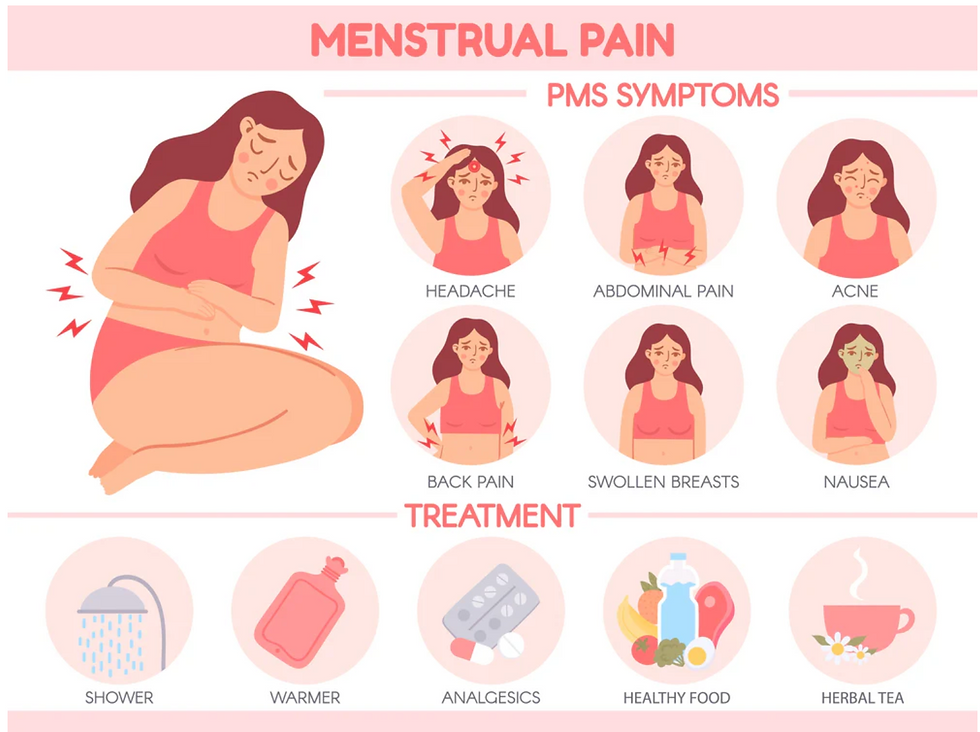Understanding and Managing Painful Periods: Your Ultimate Guide to Relief
- Aditya Agarwal
- Aug 17
- 4 min read
Are you one of the millions of women who dread "that time of the month" because of excruciating cramps, bloating, and fatigue? If painful periods (medically known as dysmenorrhea) are disrupting your life, you're not alone. In fact, up to 90% of menstruating individuals experience some level of discomfort, but for many, it's severe enough to miss work or school. Whether you're here because you've noticed this issue among your friends, family, or even your own users (as shared in community feedback), this guide is designed to empower you with knowledge, practical tips, and real relief strategies.
In this comprehensive blog, we'll dive deep into what causes painful periods, how to spot when it's more than "just cramps," and proven ways to manage them naturally and medically. Plus, we've sprinkled in interactive elements like a quick self-assessment quiz and reader polls to make your reading experience engaging and personalized. Stick around till the end for a free downloadable checklist to track your symptoms!

What Are Painful Periods? Breaking Down Dysmenorrhea
Painful periods, or dysmenorrhea, refer to the cramping pain in the lower abdomen that occurs just before or during menstruation. It's more than a minor inconvenience— it can feel like a vise grip on your uterus!
There are two main types:
Primary Dysmenorrhea: Common in younger individuals, caused by natural chemicals (prostaglandins) that make the uterus contract to shed its lining. No underlying health issues here.
Secondary Dysmenorrhea: Often starts later in life and is linked to conditions like endometriosis, fibroids, or pelvic inflammatory disease.
Why does it hurt so much? During your period, the uterus contracts to expel blood, but high prostaglandin levels can amplify these contractions, leading to pain that radiates to your back, thighs, or even causes nausea.
Quick Fact: According to recent studies from the American College of Obstetricians and Gynecologists (updated 2025), severe dysmenorrhea affects about 10-20% of women, impacting productivity and mental health.
Interactive Poll: How Bad Are Your Cramps?
Vote below and see what others are saying! (Embed a simple poll widget here if your CMS supports it, e.g., via Google Forms or PollDaddy.)
Mild: I can power through with over-the-counter meds.
Moderate: It slows me down but doesn't stop me.
Severe: I have to take time off and rest.
Results will update in real-time—check back after voting!
Common Symptoms: Is This Normal or a Red Flag?
Not all period pain is created equal. Mild cramps are par for the course, but if yours include:
Intense throbbing or cramping that lasts more than 2-3 days
Heavy bleeding that soaks through pads/tampons hourly
Nausea, vomiting, diarrhea, or headaches
Pain that worsens over time or starts suddenly
It might be time to investigate further. Track your cycle using apps like Clue or Flo for patterns—knowledge is power!

When to See a Doctor: Don't Ignore These Signs
If pain interferes with daily life, or if you experience:
Pain during sex
Irregular periods
Family history of reproductive issues
Consult a gynecologist. Early diagnosis can prevent complications. Pro Tip: Prepare for your appointment by noting symptom duration, intensity, and any triggers.
Natural Remedies: Ease the Pain Without Meds
Tired of popping pills? Here are evidence-based home remedies to try:
Heat Therapy: Apply a heating pad or warm bath to relax muscles. Studies show it can be as effective as ibuprofen for mild cramps.
Exercise: Gentle yoga or walking releases endorphins, nature's painkillers. Try poses like child's pose or cat-cow.
Diet Tweaks: Load up on anti-inflammatory foods like ginger tea, turmeric, omega-3-rich fish, and magnesium-packed nuts. Avoid caffeine and salty snacks that worsen bloating.
Herbal Helpers: Chamomile or fennel tea can reduce prostaglandin levels. Always check with a doctor if you're on medications.
Acupressure: Press the point between your thumb and index finger for quick relief—it's an ancient trick backed by modern research.
Reader Challenge: Pick one remedy from this list and try it during your next cycle. Share your results in the comments below—what worked for you?

Medical Treatments: When Home Remedies Aren't Enough
For persistent pain, professional help is key:
Over-the-Counter Options: NSAIDs like ibuprofen reduce prostaglandins. Start a day before your period for best results.
Hormonal Birth Control: Pills, patches, or IUDs can lighten periods and ease cramps by regulating hormones.
Prescription Meds: For severe cases, doctors may prescribe stronger pain relievers or muscle relaxants.
Advanced Therapies: If secondary dysmenorrhea is suspected, treatments like laparoscopic surgery for endometriosis could be life-changing.
Remember, what's right for you depends on your health history—always consult a healthcare provider.
Quick Quiz: Assess Your Period Pain Severity
Answer these questions to gauge your situation (score yourself: 1 point per "yes"):
Do cramps last more than 3 days?
Does pain make you miss activities?
Have you tried remedies without success?
Is pain accompanied by heavy bleeding?
0-1: Mild—monitor and try natural tips.
2-3: Moderate—see a doctor for personalized advice.
4: Severe—Seek medical help ASAP.
How did you score? Drop it in the comments and let's discuss!
Lifestyle Changes for Long-Term Relief
Prevention is better than cure! Incorporate these habits:
Stay Hydrated: Dehydration worsens cramps—aim for 8 glasses a day.
Stress Management: Meditation or journaling can lower cortisol, which amplifies pain.
Sleep Well: Poor sleep exacerbates symptoms; aim for 7-9 hours.
Track and Adapt: Use a journal or app to identify patterns, like how caffeine affects you.
By making these tweaks, many women report up to 50% reduction in pain intensity over time.

Conclusion: Take Control of Your Cycle Today
Painful periods don't have to rule your life. With the right knowledge—from understanding causes to trying natural remedies and seeking medical advice—you can reclaim your comfort and confidence. Remember, every body is unique, so listen to yours and consult professionals when needed.
Ready to start? Download our FREE Menstrual Pain Tracker App to monitor symptoms and track progress. And if this post helped, share it with a friend who's struggling—let's build a supportive community! Android : https://play.google.com/store/apps/details?id=com.menstrual.tracker
What’s your go-to remedy for cramps? Leave a comment below, and subscribe to our newsletter for more women's health tips. Your feedback shapes our content—together, we can make periods less painful for everyone.



Comments